John Cage’s genius an L.A. story
- Share via
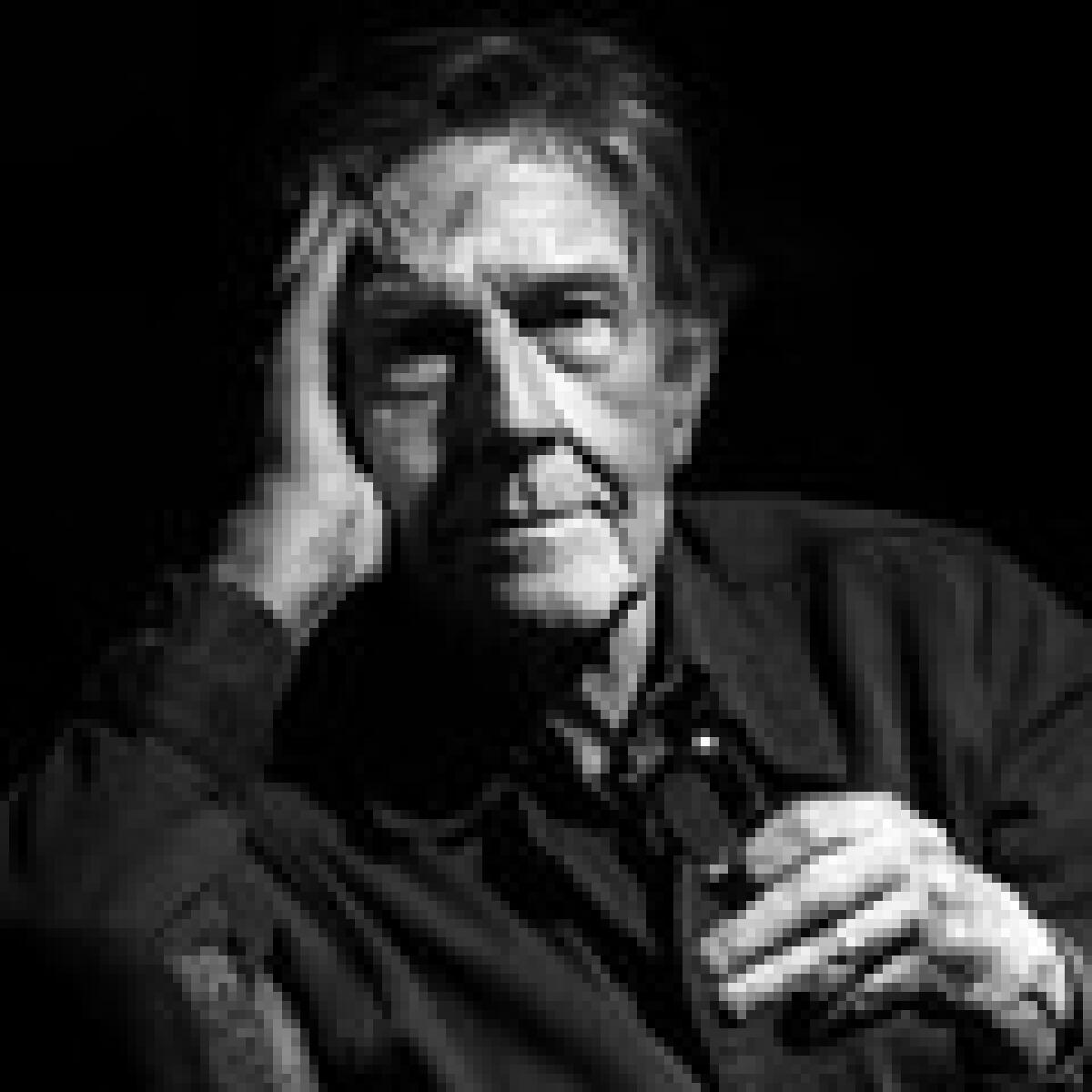
The composer is among the most innovative music figures of the 20th century. Yet his formative years in the cultural stew of 1920s and '30s L.A. get overlooked.
Timeline | Music | Inspiration | Critic's Notebook | Events
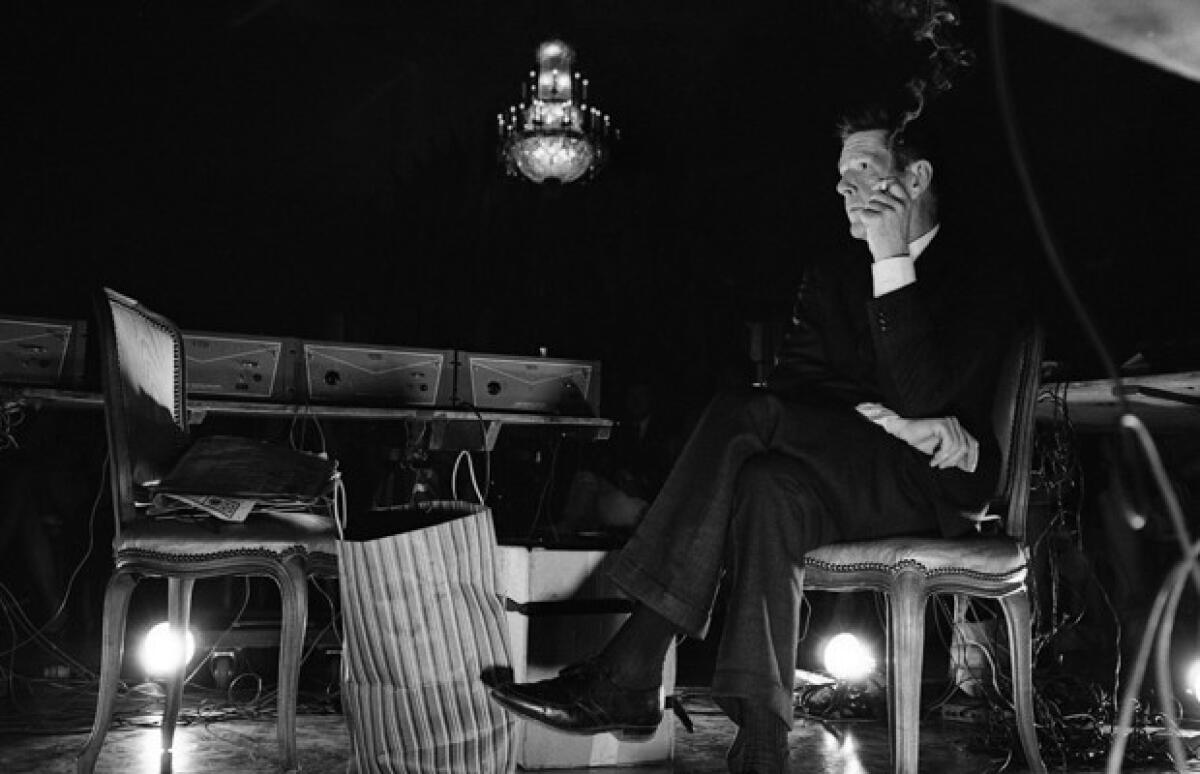
Composer John Cage during his concert held at the opening of the National Arts Foundation, Washington DC, 1966.(Rowland Scherman / Getty Images)
August 31, 2012
John Cage was born Sept. 5, 1912, at Good Samaritan Hospital in downtown Los Angeles. There is no plaque. Nor are there plaques anywhere in L.A., Long Beach, Santa Monica or Claremont, cities where Cage grew up, studied and gave his first concerts. And became John Cage.
He was, perhaps, the greatest music radical of the 20th century. He composed using chance procedures. His music honored silence along with sound. He made no distinction between traditional musical sounds and what some call noise. He embraced, rather than escaped from, messy urban life as well as anarchic nature. He was controversial, to say the least, but his influence has been, and continues to be, extraordinary. No one in the last century did more to change the way much of the world now thinks about, makes and consumes art.
Cage lived the last 50 years of his life in New York, personifying the city's avant-garde. He wrote the music for which he is known there and died in Manhattan in 1992.
But the voluminous Cage literature has underestimated or glossed over the degree to which his revolutionary ideas had their origins in the singular and sometimes outlandish L.A. cultural stew of the '20s and '30s -- a liberating, vibrantly open society where highbrow émigré artists mixed with mystics and movie stars, where artistic and sexual experimentation were not necessarily separate activities.
That may help to explain why cultural capitals on the East Coast and in Europe, Asia and South America are celebrating the Cage centennial far more robustly than is the city of his birth. Darmstadt, for instance, renamed its central station the John Cage Railway Station this summer during the term of the famous new music courses the German city holds every July. Our Union Station remains un-Caged.
But with his 100th birthday on Wednesday, this is a moment not only to take back Cage but also to maybe see a little of ourselves reflected in our still often misunderstood native son.

John Milton Cage, Jr., in Los Angeles circa 1918. (John Cage Trust)
Click here to see the full image.
L.A.'s optimism
A good place to begin is with his disarming laugh. Cage's magnificent sense of humor -- "I prefer laughter to tears," he often explained -- made him instantly likable. But that he prided himself on having been born with a sunny disposition is no wonder. The L.A. of a hundred years ago was a uniquely optimistic city.
An anything-goes boomtown, which included a madcap nascent film business, Los Angeles named its main streets downtown Temple, Charity, Faith and Hope. In 1913, we were characterized by a New York magazine as a city susceptible to "spiritualists, mediums, astrologists, phrenologists, palmists and all other breeds of esoteric wind-jammers," to say nothing of "mazdaznan clubs, yogi sects, homes of truth, cosmic fluidists, astral planers, Emmanuel movers, Rosicrucians and other boozy transcendentalists."
Spectacle was everywhere. Hollywood hillside pageants included a Theosophical Society adoration of the East and a 12-part Pilgrimage Play at the sites of the now Hollywood Bowl and John Anson Ford Theatre. As a student walking to Los Angeles High School in the '20s, Cage would pass by Aimee Semple McPherson's Angelus Temple in Echo Park, where the popular evangelist might don a USC football player's uniform to carry the ball for Christ or dress as a policeman and ride up to the pulpit on a motorcycle to put sin under arrest. When Cage turned to opera late in his life the result looked something like that. By using chance operations to make his "Europeras 1 & 2," Cage wound up with situations in which, say, a singer traditionally costumed for a 19th century opera might enter on a jeep.
Idiosyncratic spectacle was, in fact, part of Cage's DNA. The first one he witnessed was as an infant, but he spoke about it all his life. On a late spring afternoon in 1913, the tip of a submarine emerged from the bottom of the Long Beach harbor where it had been buried under five feet of mud for 36 hours. Thousands of spectators let out thunderous cheers. Nearby factories blasted their whistles. Three dozen boat launches honked their foghorns.
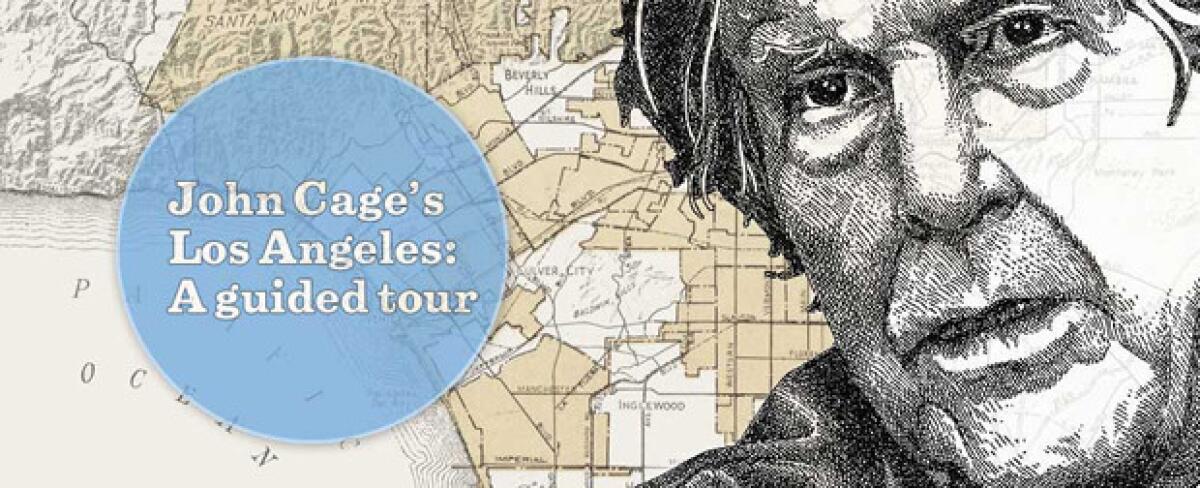
Take an interactive tour of John Cage's Los Angeles. (Lily Mihalik / Los Angeles Times)
That glorious racket was what would now, no doubt, be called Cagean.
Stepping off one of those launches, the mayor of Long Beach walked onto the flat top of the sub and cut the seal with a knife. Out climbed the sub's inventor and his crew. They had just broken the world's underwater record by a dozen hours, and the inventor said he felt "dandy." The event was the top story on the front page of The Times the next morning under the headline: "Comes Up Famous." A picture shows the young inventor in a bowler hat kissing his stylish wife. These were John Cage's parents.
John Milton Cage Sr., was a visionary inventor. He worked on forerunners of color television, sonar and homeopathic medicine (Cage swore by his dad's "Mist-A-Cold" inhaler). When he died in 1964, Milton, as he was called, was toying with the idea of space travel based upon gravitation that he felt would show Einstein the error of his ways.
After advertising stock for his submarine company in The Times at a dollar a share, Milton raised $1 million. But the craft was of no value to the U.S. Navy because his sub released air bubbles revealing its location. Milton went bankrupt and fled town.
John Jr., an only child, spent his preschool years in Detroit, where Milton taught engineering. Another fiasco, though, sent the family high-tailing it back to L.A. after Milton invented what was then the world's most powerful airplane engine, so strong that it blew apart its housing and thus also proved useless.
Influences:
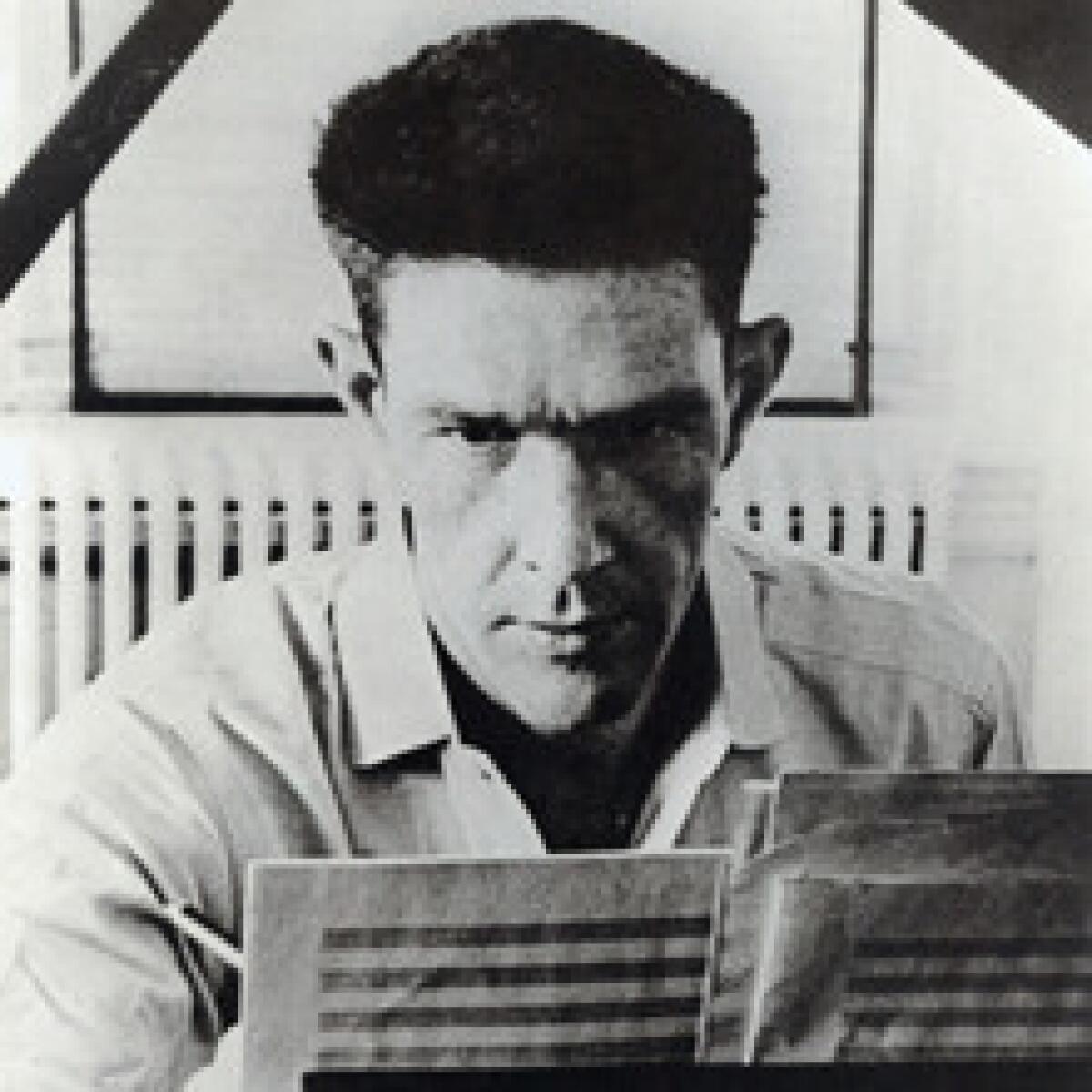
John Cage's reach extended well beyond experimental music:
He influenced the Beatles' Paul McCartney and John Lennon and artists in several other genres.
Photo: John Cage circa 1971. (International Portrait Gallery)
Milton built a Craftsman-style house for his family in Eagle Rock and turned to experimenting with early radio, which caught his son's fancy. In 1924, 12-year-old John Jr. began a weekly show about the Boy Scouts at KNX, which had been started four years earlier in the bedroom of L.A.'s first disc jockey, Fred Christian. Cage delivered the local Boy Scout news, played the piano (mostly Grieg) and invited clergy of various denominations to give inspirational talks. This proved so popular that the Boy Scouts took over the time slot. Without Cage, though, listenership plummeted and KNX pulled the show off the air.
Cage's first piano teacher was his Aunt Phoebe, his mother's sister. Phoebe James was a remarkable pedagogue who developed unconventional (that is to say conventionally Cagean) methods of teaching music to children that included jiggling balloons filled with rice and hitting radiators with sticks. At Los Angeles High School, Cage had another enlightened music teacher, Fannie Charles Dillon, a concert pianist and pioneering female composer who adapted bird calls into her scores.
The 1928 class valedictorian, Cage graduated with the highest scholastic average at the time in L.A. High's history, and he represented his school in an oratorical contest that spring at the Hollywood Bowl. His winning speech proposed a day of quiet for all Americans. By being hushed and silent, he said, "we should have the opportunity to hear what other people think." Nearly a quarter-century later, Cage would shock the musical world with his composition "4'33." For four minutes and 33 seconds, the performer remains silent, inviting the audience to appreciate sound as an inescapable -- and enjoyable -- aspect of our environment.
Cage entered Pomona College that fall as a theology major, but his interests quickly turned elsewhere. His enthusiasm for the French artist Marcel Duchamp, who became one of Cage's most significant influences, can be traced to José Pijoan, a Portuguese art professor at Pomona. Henry Cowell, the innovative California composer who would later become Cage's first important mentor and champion, gave a recital at Pomona, hitting the keyboard with his fists and elbows and directly plucking the piano's strings.
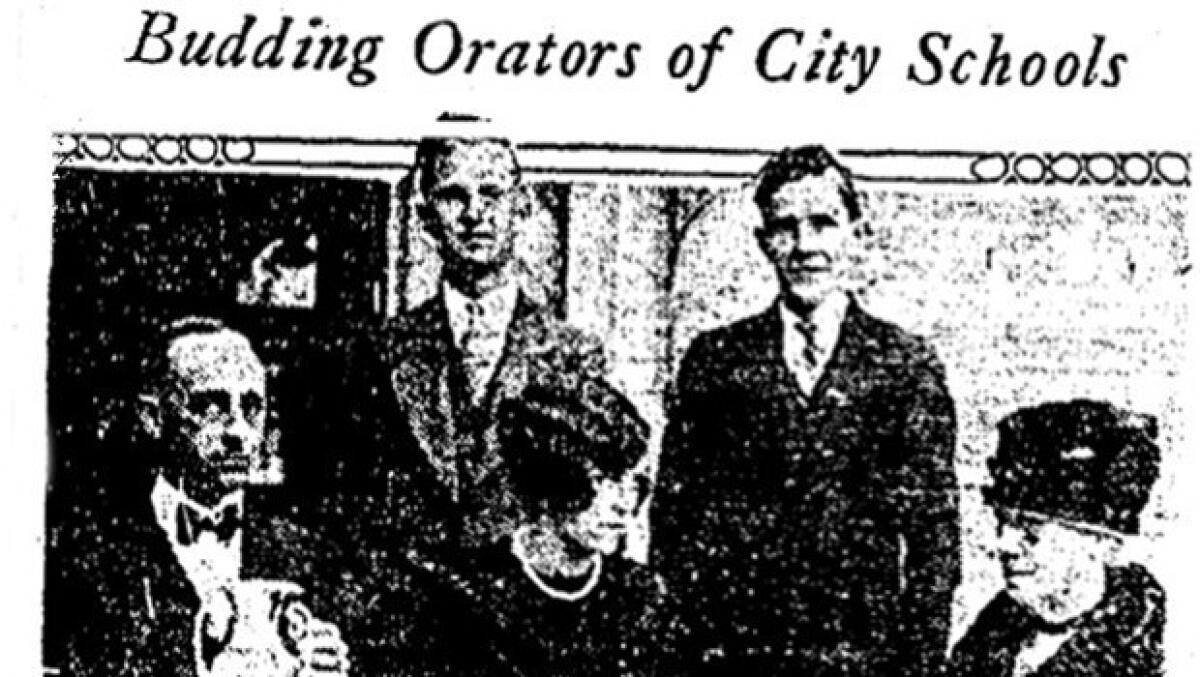
John Milton Cage, Jr., and John H. Gregg: below, William R. Roalfe, Miss Katherin Welborn and Superintendent of Schools Dorsey in a photo that appeared in the Los Angeles Times on December 22, 1927. (Los Angeles Times)
Click here to see the full image.
Cage discovered the writing of the Indian art theorist Ananda Coomaraswamy -- on which he based his notions about the role of nature and the emotions in his music of the '40s and early '50s -- at Pomona when Coomaraswamy's musician wife, Ratan Devi, visited the campus. But it was Don Sample, a pretentious Harvard grad and drifter who was hanging around Claremont, who changed Cage's life.
Sample induced Cage to help him curate an art exhibit, and he introduced Cage to the work of James Joyce, a writer who served as a source of inspiration throughout Cage's life. Cage's decision to drop out of Pomona after his sophomore year and go to Europe was at least in part to meet up with Sample. Whether they first became lovers in Claremont or in Europe is unclear.
Transformation
Cage went to Europe thinking himself a writer, but, after a few piano lessons at the Paris Conservatory and a year wandering around Europe and North Africa with Sample, Cage returned to L.A. in 1932 a composer of mathematically constructed scores and also a painter who took his inspiration from squinting at the sun (juvenilia that was either destroyed or lost). At first Cage and Sample stayed with Cage's parents, disguising their affair. Thanks to his invention of the electric radio, Milton had been able to afford a large house in Pacific Palisades, but the Depression had by now wiped him out, and the family had been forced to sell all the furniture. Even this became a Cage trope. During his early years in New York, he lived in an artfully decorated but unfurnished downtown loft that was famously photographed by New York fashion magazines.
The early '30s was a time when L.A. had begun its transformation from provincial city into a cosmopolitan arts center, much bolstered by the great Russian and German émigré artists who had begun to arrive. And so, almost laughably, began the 20-year-old Cage's own transformation. Late in 1932, Cage, Sample and a high school friend of Cage's, Harry Hay (who would become a prominent gay activist), put on Cage's first concert at the Santa Monica Bay Woman's Club, where Cage's mother was a member.
Video:
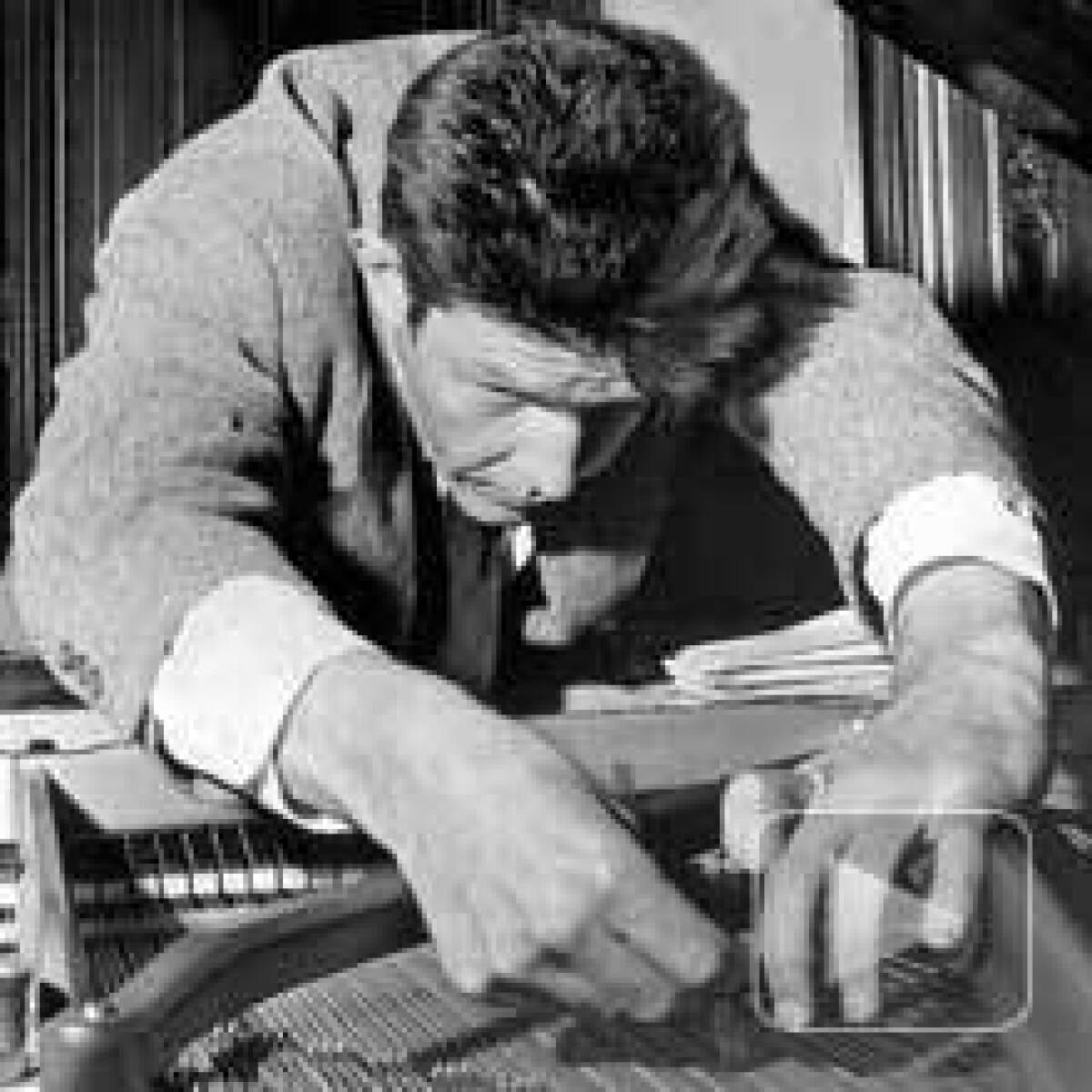
A cross section of John Cage compositions:
"Credo in Us," "Sonatas and Interludes," "4'33'" and "Atlas Eclipticalis" are among the works that show the composer's range.
Photo: John Cage prepares a piano in the mid-1950s. (Los Angeles Times)
Hay sang. Cage played the piano. For a song that Cage had written to a text by Aeschylus about the death of Xerxes, Hay donned white blankets upon which colored patterns were projected by a fluorescent light source that Milton rigged up. Once again, Milton didn't quite anticipate the consequences of his invention, and the projector got so hot that the velum upon which the designs were painted began to run. The ladies in the audience were bewildered.
As the family fortunes continued to fall, the Palisades house was sold, and the Cages moved downtown. John's mother, Lucretia, took a job as women's club editor at The Times. Under the byline Crete Cage, she wrote more than 1,600 columns that chronicled her times and her town by reporting on the daily speakers at the city's many clubs. These were often national figures and their topics were social, political and artistic issues. Not only did Crete instill a concern for society in her son that became the essence of his thought, but he was greatly influenced by her elegantly clear writing style.
Cage and Sample moved into an auto court in Santa Monica, and also lived briefly in one of the rooms the architect Rudolph Schindler lent out to artists in his famed house on Kings Road in West Hollywood. There Cage met German art dealer Galka Scheyer, a patron of the Expressionist painters she had dubbed the Blue Four (which included Paul Klee and Wassily Kandinsky).
Through Scheyer, Cage heard about pianist Richard Buhlig, the first important musician to take an interest in the young composer. Though now forgotten, the Chicago-born pianist was also the first to play a complete cycle of Beethoven's 32 piano sonatas in L.A. and the first to record Bach's "Art of the Fugue."
Buhlig, who was a student of Hinduism and Buddhism, is the one who planted the seed in Cage that he needed to do something about his obviously large ego and get beyond his likes and dislikes so he could be open to new discoveries. He told Cage that listening with preconceived notions was listening with opinion.
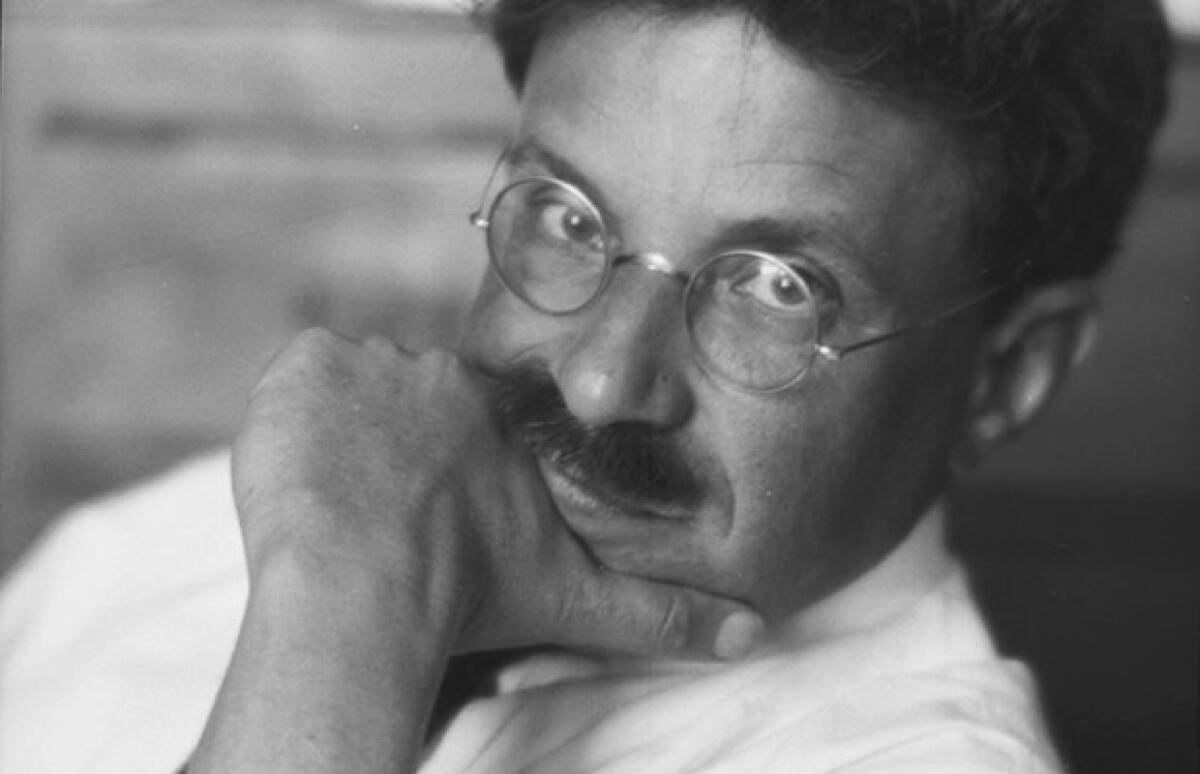
Portrait of Richard Buhlig circa 1930. (Johan Hagemeyer / Online Archives of California / The Bancroft Library).
Click here to see the full image.
And he sent Cage to Henry Cowell, who then prepared Cage to study with Arnold Schoenberg. The Austrian composer had recently emigrated to L.A. from Berlin to escape Nazi persecution, and Cage took his courses at USC, UCLA and Schoenberg's Brentwood home.
Most of the time Cage spent with Schoenberg was devoted to traditional harmony and counterpoint exercises, rather than learning the 12-tone technique that Schoenberg had invented to do away with conventional harmony. On his own, Cage drafted a collective of bookbinders (with whom he shared a house in Santa Monica) into a percussion ensemble and wrote pieces for them that applied Schoenberg's structural principals to rhythmic cells. Schoenberg, however, thought this of little interest.
Fed up with repeatedly having to study the composer's harmony textbook, "Harmonielehre," Cage dropped out of Schoenberg's UCLA class in 1936 after having devoted himself to the master for nearly two years. Still the young composer continued to, as he put it, worship Schoenberg like a god. He took away from Schoenberg the idea that a composer always needed some kind of system. And Cage always came up with one.
Complicated love life
In order to become musically focused during his studies with Schoenberg, Cage realized that he needed to greatly simplify his personal life, which had become promiscuous. He continued his relationship with Sample, and both had other male partners as well. But Cage had also been involved in a passionate love affair with Schindler's wife, Pauline, who was 19 years his senior. She had separated from her husband and was living in Ojai.
Then one day Xenia Andreyevna Kashevaroff walked into an arts and craft shop downtown that Crete ran during the years she wrote her Times columns. The daughter of a Russian Orthodox priest in Alaska, Kashevaroff was a beauty who had been photographed nude by Edward Weston and had been part of John Steinbeck's circle in Salinas. When John saw her, it was, he said, love at first sight.
For a while Cage juggled all three lovers, turning to a not-particularly receptive Pauline for advice about how to woo Kashevaroff. In the end, Cage and Kashevaroff drove to Yuma, Ariz., and got married on June 7, 1935. His mother put the announcement in The Times.
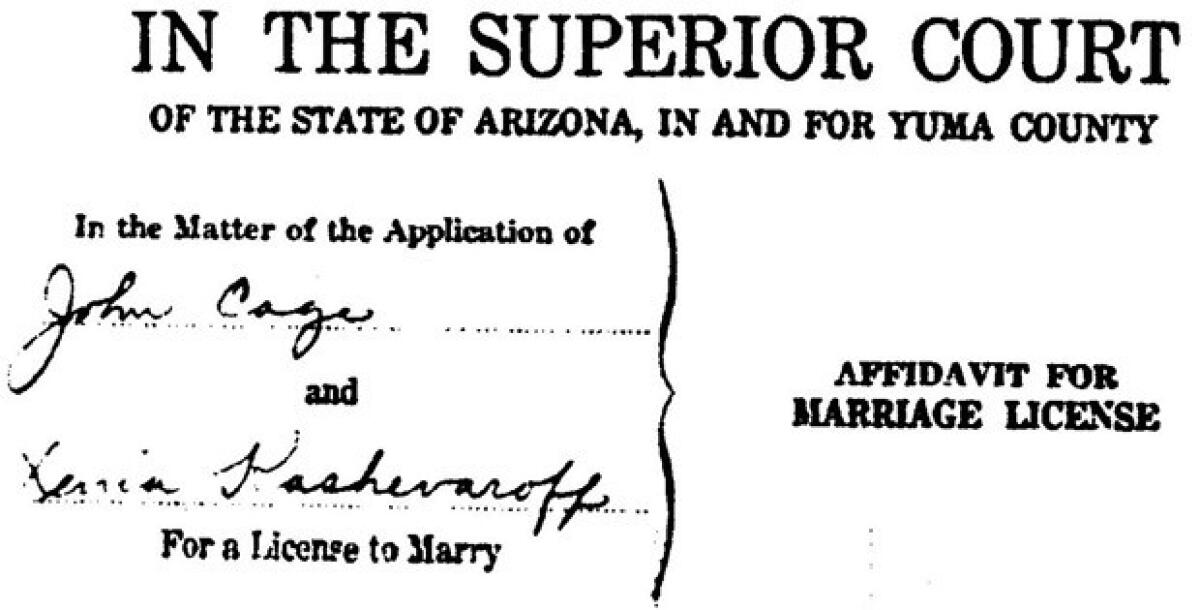
Marriage license between John Cage and Xenia Andreyevna Kashevaroff June 7, 1935 in Yuma, Arizona. (John Cage Trust) Click here to see the full image.
Cage spent two more years in L.A. after leaving Schoenberg's class. This is when he began to find his voice, and it would be hard to imagine that happening in quite the same way anyplace else. One inspiration was the animator Oskar Fischinger . A German émigré whose application of classical music to abstract imagery was one of the models for the Disney film "Fantasia," Fischinger practiced Buddhism and further paved the way for Cage's later fascination with Zen. He also provided Cage with a model for eloquent graphic notation, which would become another Cagean hallmark.
Next, Cage accompanied dance at UCLA either on the piano or with percussion, and he assisted his Aunt Phoebe in her music education classes at UCLA's progressive elementary school on Sunset Boulevard. For an aquatic ballet, Cage came up with the idea of a dipping a gong into the pool so the swimmers could hear it underwater. The water gong was the first among a great many original sound-producing contraptions the son of an inventor would devise throughout his career.
His teaching was equally revolutionary. He put together a list of 10 "Rules and Hints for Student and Teachers, or Anybody Else." Rule 4 is "Consider everything an experiment." Rule 6 begins "Nothing is a mistake." Rule 9 advises "Be happy whenever you can manage it." Rule 10 advocates breaking all the rules, "even our own rules." It was at the UCLA elementary school where Cage first experimented with placing household objects on or in between the strings of the piano to create a new percussion effect.
Around the time of his 26th birthday, Cage took a job as a dance accompanist at the Cornish School in Seattle, where he claimed to have invented the prepared piano, in which he inserted nut and bolts, screws and rubber erasers inside the piano. This radically changed the nature of the piano, turning it into a gently startling one-man percussion band, and it was one of the things for which he became known. But the prepared piano's origins were decidedly on Sunset Boulevard.
His final companion
After two years in Seattle, a year in the San Francisco Bay Area and a year in Chicago, Cage moved to New York. He and Kashevaroff divorced after 10 years of marriage, and Cage spent the rest of his life with dancer and choreographer Merce Cunningham, whom he had met at Cornish.
Events:

Remembering John Cage
at 100
What would have been John Cage's 100th birthday on Wednesday is being celebrated around the globe throughout the year. Here's a selective listing.
Photo: John Cage circa 1988. (Photo by Paul Bergen / Redferns)
Cage's parents also came East and Cage's trips back to L.A. were infrequent and always to give performances. But he also often acknowledged his debt to his hometown, and one way he did so was by accepting an honorary degree from the California Institute of the Arts in 1986. He had been offered many others but turned all the others down.
I lived in New York during the last four years of Cage's life and spent as much time around him as I could. He had felt I might make a good biographer for a biography he didn't really want written. But he did seem almost obsessed with youth. He particularly liked to speak about his father, whom he adored but hardly knew. When Milton was busy on an invention, he might not emerge from his laboratory for days on end. And Cage acknowledged that this led him to seek out father figures, such as Schoenberg and Duchamp.
Nor did he ever stop trying to prove himself to Schoenberg. A system he called anarchic harmony, upon which he based his late music, was his answer to his old teacher. During Cage's final summer, he even began rereading the Austrian master's "Harmonielehre."
Shortly before Cage suffered his fatal stroke, I happened to call his assistant, the Cage authority Laura Kuhn, who now heads the John Cage Trust at Bard College in New York. An enormous thunderstorm was brewing. "John," Kuhn relayed, "says it's going to rain like hell."
She then handed him the phone to say hello. I joked that it would be a good, spooky night to read "Harmonielehre." "Oh, I've finished that," he said. "Isn't that marvelous?"
About a half-hour later, Cage collapsed on his kitchen floor and never regained consciousness. He was alone. Kuhn had left and Cage was making lemonade for Cunningham, who was on his way home. Whatever his last thoughts were, Los Angeles hadn't been far away.
Timeline | Music | Inspiration | Critic's Notebook | Events
Graphic credits: Doug Stevens | Design and production by Lily Mihalik
The biggest entertainment stories
Get our big stories about Hollywood, film, television, music, arts, culture and more right in your inbox as soon as they publish.
You may occasionally receive promotional content from the Los Angeles Times.







